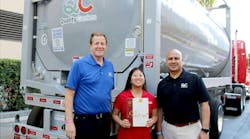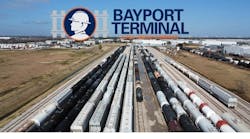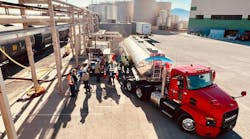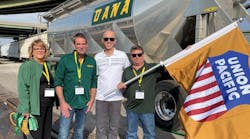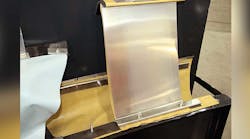WHEN it comes to floating roof seal inspections, it’s critical to be proactive by maintaining an inspection schedule, knowing the regulatory requirements, and planning and preparing. But nothing is more critical than safety—and that involves a Job Hazard Analysis (JHA), safe work plan, and permits.
“Safety is the most important part of this whole thing,” said Jeff Eickhoff, vice president of Americas–HMT LLC. He discussed safety and the floating roof inspection process during the International Liquid Terminals Association’s 2016 International Operating Conference May 23-25 in Houston, Texas.
During his presentation, “Safety Considerations for Conducting Floating Roof Seal Inspection,” Eickhoff first established that a floating roof is a control device—a structural mechanism that floats right on top of a liquid surface and is meant to prevent evaporation.
“But because tanks are never built perfectly round, they settle and get deformations in them,” he said. “The floating roof has to be designed at a smaller diameter so it can pass fully up and down. So that perimeter space of seven to 10 inches has to be sealed to prevent evaporation of liquid in that area.”
He said there are two classifications of federal air rules driving seal inspection:
• Volatile Organic Compounds (VOC) rules. Standards of Performance for New Stationary Sources (NSPS) rules, which involve 40 CFR Part 60 Subparts K, Ka, Kb.
• Hazardous Air Pollutants (HAP) rules. National Emission Standard for Hazardous Air Pollutants (NESHAP) include the old NESHAPs in 40 CFR Part 61 Subpart Y (Benzene).
“Things really changed in 1990 with the Clean Air Act, providing two paradigm shifts: burden of proof of toxicity and source-category driven rules: refinery MACT (major sources) – 40 CFR Part 63 Subpart CC; gasoline distribution MACT (major sources)–40 CFR Part 63 Subpart R; gasoline distribution GACT (minor sources)–40 CFR Part 63 Subpart BBBBBB; and organic liquid distribution MACT (major sources)–40 CFR Part 63 Subpart EEEE.”
The requirements differ between internal and external floating roofs:
• Internal. “Before filling, visually inspect the internal floating roof and seals. Annually, visually inspect IFR and seals from the fixed-roof manway or inspection hatch. Every 10 years or whenever the tank is emptied and degassed, inspect IFR, seals, gaskets, slotted membranes, and sleeve seals.
• External. “They are generally safer to climb onto. You are going to be able to see better, the air circulation and ventilation are better, and access and egress are safer. The first inspection is during hydrostatic testing or within 60 days of fill, performing the primary and secondary seal gap measurements—seal gap areas and maximum widths. Annual testing includes secondary seal gap measurements. Every five years, do the primary seal gap measurements. Whenever the tank is emptied/degassed, visually inspect the EFR, seals, and fittings.”
Gap criteria for external seal inspections:
• Primary seal gaps. Total accumulated gap area shall not exceed 212 cubic centimeters per meter of nominal diameter (10 square inches per foot of nominal diameter). Maximum gap allowed is 3.81 cm (1.5 inches).
• Secondary seal gaps. Total accumulated gap area shall not exceed 21.2 cubic cm per meter of nominal diameter (1 cubic inches per foot of nominal diameter). Maximum gap allowed is 1.27 cm (0.5 inches).
“With secondary gap inspections, walk the tank and measure the gaps, probing as you go,” he said. “With primary gap inspections, it’s a two-man operation where you pull back secondary seals and look for gaps. Be cognizant of secondary components—shunts, etc. When a potential primary gap is spotted, block the secondary open to allow for accurate measurements. For a mechanical shoe seal, the gap must be at product level.
“Although not always required, it’s best to check all fabrics and elastomers every time you’re on the tank. Check the compression system of the seal. Check the roof drain sump to ensure it is clear of debris and open to flow freely. Additionally, pontoons should be inspected if the lids are accessible.”
For internal floating roofs, after installation, record that the IFR meets the specification in §60.112b (a)(1). There should be a record of each inspection, defects found, and corresponding repairs. Make sure you understand record retention requirements and comply.
For external floating roofs, after installation, record that EFR meets the specifications in §60.112b (a)(2) and §60.113b (b)(2), (b)(3), and (b)(4). There should be a record of all seal gap inspections, defects found, and corresponding repairs. Make sure you understand record retention requirements and comply.
Planning and approach considerations:
• Maintain an inspection schedule (formal program). “Plan to minimize disruptions and spread out annual inspections to prevent buildup of an inspection backlog. Don’t wait until the last minute. Have operations personnel look for potential issues when they are pulling samples.
• Coordinate with operations. “You want to ensure the tank is as full as possible and is static for at least four hours prior to inspection.”
• Collaboration between inspection and maintenance. “Utilize good training and communication to ensure repairs are specified and scheduled properly the first time.”
• Consider a specialized seal inspection contractor. “Make sure they are trained and familiar with the regulations and trained and familiar with repair materials and procedures.”
Elaborating on safety considerations, he said working on an in-service floating roof requires: disciplined planning; thorough job hazard analysis; proper personal protective equipment (PPE); compliance with OSHA confined space regulations 29 CFR 1910.146; compliance with facility safety protocol and permit system; thorough safe work plan and procedures; well-trained personnel who understand what they’re doing; vigilance and constant hazard awareness throughout the inspection.
The JHA provides an assessment of potential hazards, risk, and mitigation methods. The Safe Work Plan is a comprehensive plan that covers the work to be done, potential hazards, level of risk and hazard mitigation methods, permits required, and pre- and post-job activity. Know the customer’s permit process and make sure you comply. Typical permits required: Confined space permit and safe work/cold work permit.
There are a number of things to consider when looking at potential hazards:
• Stored product properties–review. Understand the stored product toxicity, flammability, corrosiveness, and pyrophoric properties. Understand product-specific hazards.
• Condition of the floating roof. Has the roof recently been inspected? Are there any potential conditions that could impact safety? Any hazards on the roof such as water, ice, snow, etc?
• Roof should be as high as possible and static. This influences air circulation and egress The roof must not be landed. It should be static four hours to allow the atmosphere to stabilize.
• Access and egress. Know floating roof access points. How will you egress if you have a problem? What is the potential for entanglement of air or rescue lines? What is the rescue plan?
• Extra considerations for IFRs. What is the construction of the roof, and is it suitable for walking? Consider the lighting, or lack thereof. Are access and egress highly restricted? Atmospheric risks are typically much higher. Extra care should be taken to review the hazards and safe work plan.
• Thunderstorms. Care should be taken to avoid them.
• Rain, snow, ice, wind, and cold. They can produce slips, trips, and falls, and affect mobility.
• Heat exposure. Heat affects supplied-air efficiency. Stay hydrated. Workers should keep an eye on each other for signs of heat stress.
“Air monitoring typically involves a four-gas monitor,” he said. “You need to understand what you’re monitoring and also what other chemicals may be present, as some chemicals will damage certain sensors. Make sure the monitor is calibrated and make sure it’s bump tested on a daily basis. A sensor’s useful life varies but is typically two to three years max.”
With fire retardant clothing (FRC), the standard PPE consists of a hard hat, safety glasses, cut-resistant gloves, and safety shoes. Supplied air is SCBA for short-duration/initial air monitoring and supplied air respiratory (SAR) for long-duration work.
“Supplied air is to be certified Grade D breathing air,” he said. “It must be fit-tested for the mask. With the SCBA, the Self Contained Breathing Apparatus or ‘air pack,’ a 30-minute bottle is most common. However, you won’t get 30 minutes out of it. Time will vary by individual—lung volume, fitness level, breathing discipline, temperature in the tank, and familiarity with the equipment. With the supplied air respiratory or ‘cascading system,’ there are typically one to two bottles in the system for a seal inspection. You must be careful to avoid entanglement.”
The safety plan requires rescue considerations: Who is responsible for the rescue—contractor, host, or third party? Are there other emergency response resources? Before proceeding, the inspection contractor should review the rescue plan to ensure they understand all elements. Is there a plan for a high-angle rescue that uses devices such as a tripod and pulley system to raise and/or lower the person to safety?
Considerations for out-of-service inspections include: collapse from lateral or rotational movement; support failure from corrosion, leg kick-out (out-of-plumbness) or improper pinning; roof overloading from rainwater or product; roof overloading from equipment or materials; and roof overloading from improper venting.
“You should never do a seal inspection alone,” he said. “Always have at least one standby person in a safe location to observe you. Always ensure that someone not at the tank knows you are entering the tank. Always ensure there is a means of emergency notification.” ♦




